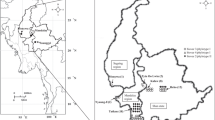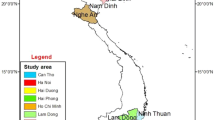Abstract
Causing potato brown rot, Ralstonia solanacearum (R. solanacearum) strains are reported as one of the most destructive bacteria to potato (Solanum tuberosum L.) in China. In this study, 113 strains were isolated from potato, collected in the four major agroecological zones in China. The study showed that 102 strains belonged to the phylotype IIB sequevar 1 (race 3 biovar 2). The 11 remaining strains belonged to the phylotype I, sequevar 13, 17, 18, 16 or 14 M, a new sequevar closely related to sequevar 14. Thirty-four strains were further characterized according to their virulence at low temperature on three wild potato species. IIB-1 strains all belonged to high and moderate virulence, while others belonged to the low virulence group, which had limited pathogenicity.
Resumen
Causante de la pudrición café, se reporta a las variantes de Ralstonia solanacearum (R. solanacearum) como una de las bacterias más destructivas en papa (Solanum tuberosum L.) en China. En este estudio, se aislaron 113 cepas en papa, que se colectaron en las cuatro zonas agroecológicas principales en China. El estudio mostró que 102 variantes pertenecían al filotipo IIB sequevar 1 (raza 3, biovar 2). Las 11 variantes restantes pertenecían al filotipo I, sequevar 13, 17, 18, 16 o 14 M, un nuevo sequevar estrechamente relacionado con el sequevar 14. Posteriormente se caracterizaron 34 cepas de acuerdo con su virulencia a baja temperatura en tres especies silvestres de papa. Todas las cepas IIB-1 pertenecieron a los grupos de virulencia alta y moderada, mientras que otras pertenecieron al grupo de baja virulencia, el cual tuvo patogenicidad limitada.





Similar content being viewed by others
References
Aundy, K., P.P. Thekken, and P. Birendranath. 2014. Genetic characterization of an Indian isolate of Ralstonia solanacearum race 3/ biovar 2/ phylotype IIB from potato. Indian Phytopathology 67 (4): 346–352.
Buddenhagen, I., L. Sequeira, and A. Kelman. 1962. Designation of races in Pseudomonas solanacearum. Phytopathology 52: 726.
Cellier, G., and P. Prior. 2010. Deciphering phenotypic diversity of Ralstonia solanacearum strains pathogenic to potato. Phytopathology 100 (11): 1250–1261.
Cellier, G., B. Remenant, F. Chiroleu, P. Lefeuvre, and P. Prior. 2012. Phylogeny and population structure of brown rot-and Moko disease-causing strains of Ralstonia solanacearum phylotype II. Applied and Environmental Microbiology 78 (7): 2367–2375.
Clarke, C.R., D.J. Studholme, B. Hayes, B. Runde, A. Weisberg, R. Cai, T. Wroblewski, M.C. Daunay, E. Wicker, J.A. Castillo, and B.A. Vinatzer. 2015. Genome-enabled phylogeographic investigation of the quarantine pathogen Ralstonia solanacearum race 3 biovar 2 and screening for sources of resistance against its core effectors. Phytopathology 105 (5): 597–607.
Cruz, L., M. Eloy, F. Quirino, H. Oliveira, and R. Tenreiro. 2012. Molecular epidemiology of Ralstonia solanacearum strains from plants and environmental sources in Portugal. European Journal of Plant Pathology 133 (3): 687–706.
FAO. 2014. Website: http://faostat.fao.org/.
Fegan, M., and P. Prior. 2005. How complex is the ‘Ralstonia solanacearum species complex’. In Bacterial wilt disease and the Ralstonia solanacearum species complex, ed. C. Allen, P. Prior, and A.C. Hayward, 449–462. Madison: APS Press.
Fegan, M., and P. Prior. 2006. Diverse members of the Ralstonia solanacearum species complex cause bacterial wilts of banana. Australasian Plant Pathology 2006 (35): 93–101.
Fegan M, M. Taghavi, L.I. Sly and A.C. Hayward. 1998. Phylogeny, diversity and molecular diagnostics of Ralstonia solanacearum. In Bacterial Wilt Disease: Molecular and Ecological Aspects, eds. P. Prior, C. Allen and J. Elphinstone, 19–33. Berlin: Springer.
Hayward, A.C. 1964. Characteristics of Pseudomonas solanacearum. Journal of Applied Bacteriology 27: 265–277.
Hayward, A.C. 1991. Biology and epidemiology of bacterial wilt caused by Pseudomonas solanacearum. Annual Review of Phytopathology 29: 65–87.
He, Y.K., Z.J. Zhao, Y.H. Li, Z.K. Zhang, X.P. Li, and J.X. Deng. 1999. A study on biotype of strains of Pseudomonas solanacearum of potato in Yunnan. Southwest China Journal of Agricultural Sciences 04: 78–81.
Hong, J.C., D.J. Norman, D.L. Reed, M.T. Momol, and J.B. Jones. 2012. Diversity among Ralstonia solanacearum strains isolated from the southeastern United States. Phytopathology 102 (10): 924–936.F.
Horita, M., and K. Tsuchiya. 2001. Genetic diversity of Japanese strains of Ralstonia solanacearum. Phytopathology 91 (4): 399–407.
Horita, M., K. Tsuchiya, Y. Suga, K. Yano, T. Waki, D. Kurose, and N. Furuya. 2014. Current classification of Ralstonia solanacearum and genetic diversity of the strains in Japan. Journal of General Plant Pathology 80 (6): 455–465.
Huerta, A.I., A. Milling, and C. Allen. 2015. Tropical strains of Ralstonia solanacearum outcompete race 3 biovar 2 strains at lowland tropical temperatures. Applied and Environmental Microbiology 81 (10): 3542–3551.
Jansky, S.H., L.P. Jin, K.Y. Xie, C.H. Xie, and D.M. Spooner. 2009. Potato production and breeding in China. Potato Research 52 (1): 57–65.
Jeong, Y., J. Kim, Y. Kang, S. Lee, and I. Hwang. 2007. Genetic diversity and distribution of Korean isolates of Ralstonia solanacearum. Plant Disease 91 (10): 1277–1287.
Jukes, T.H., and C.R. Cantor. 1969. Evolution of protein molecules. In Mammalian protein metabolism, ed. H.N. Munro, 121–132. New York: Academic.
Kelman, A. 1954. The relationship of pathogenicity in Pseudomonas solanacearum to colony appearance on a tetrazolium chloride medium. Phytopathology 44: 693–695.
Khoodoo, M.H.R., E.S. Ganoo, and A.S. Saumtally. 2010. Molecular characterization and epidemiology of Ralstonia solanacearum race 3 biovar 2 causing brown rot of potato in Mauritius. Phytopathology 158 (7–8): 503–512.
Li, Y.Y., H.L. Liu, L. Zheng, J.B. Huang and X.H. Li. 2015. Research progress on genetic diversity of Ralstonia solanacearum in China. Journal of Anhui Agriculture Sciences 14: 107–110, 112.
Li, Y.Y., F. Ji, H.L. Wang, H. Tom, X.H. Li, and J.B. Huang. 2016. Genetic diversity and pathogenicity of Ralstonia solanacearum causing tobacco bacterial wilt in China. Plant Disease 100: 1–9.
Lin, J.J., Q. Huang, F.R. Gui, M.F. Zheng, Z.Y. Li, and Y.X. Sun. 2004. Comparison of pathogenicity for Ralstonia solanacearum of potao in Yunnan province. Southwest China Journal of Agricultural Sciences 06: 738–740.
Lin, C.H., K.C. Tsai, P. Prior, and J.F. Wang. 2014. Phylogenetic relationships and population structure of Ralstonia solanacearum isolated from diverse origins in Taiwan. Plant Pathology 10 (1111): 12209.
Milling, A., F.H. Meng, T.P. Denny, and C. Allen. 2009. Interactions with hosts at cool temperatures, not cold tolerance, explain the unique epidemiology of Ralstonia solanacearum race 3 biovar 2. Phytopathology 99 (10): 1127–1134.
Nouri, S., M. Bahar, and M. Fegan. 2009. Diversity of Ralstonia solanacearum causing potato bacterial wilt in Iran and the first record of phylotype II/biovar 2T strains outside South America. Plant Pathology 58: 243–249.
Opina, N., F. Tavner, G. Hollway, J.F. Wang, T.H. Li, and R. Maghirang. 1997. A novel method for development of species and strain-specific DNA probes and PCR primers for identifying Burkholderia solanacearum. Asia-Pacific Journal of Molecular Biology and Biotechnology 5: 19–30.
Patil, V.U., J. Gopal, and B.P. Singh. 2012. Improvement for bacterial wilt resistance in potato by conventional and biotechnological approaches. Agriculture Research 1 (4): 299–316.
Poussier, S., P. Prior, J. Luisetti, A.C. Hayward, and M. Fegan. 2000. Partial sequencing of the hrpB and endoglucanase genes confirms and expands the known diversity within the Ralstonia solanacearum species complex. Systematic and Applied Microbiology 23 (4): 479–486.
Sagar, V., A. Jeevalatha, S. Mian, S.K. Chakrabarti, M.S. Gurjar, R.K. Arora, S. Sharma, R.R. Bakade, and B.P. Singh. 2014. Potato bacterial wilt in India caused by strains of phylotype I, II and IV of Ralstonia solanacearum. European Journal of Plant Pathology 138 (1): 51–65.
Scherf, J.M., A. Milling, and C. Allen. 2010. Moderate temperature fluctuations rapidly reduce the viability of Ralstonia solanacearum race 3, biovar 2, in infected geranium, tomato and potato plants. Applied and Environmental Microbiology 76 (21): 7061–7067.
Siri, M.I., A. Sanabria, and M.J. Pianzzola. 2011. Genetic diversity and aggressiveness of Ralstonia solanacearum strains causing bacterial wilt of potato in Uruguay. Plant Disease 95 (10): 1292–1301.
Toukam, G.M.S., G. Cellier, E. Wicker, C. Guilbaud, R. Kahane, C. Allen, and P. Prior. 2009. Broad diversity of Ralstonia solanacearum strains in Cameroon. Plant Disease 93 (11): 1123–1130.
Ustun, N., M. Ozakman, and A. Karahan. 2008. Outbreak of Ralstonia solanacearum biovar 2 causing brown rot on potato in the Aegean region of Turkey. Plant Disease 92 (6): 973–973.
Villa, J.E., K. Tsuchiya, M. Horita, M. Natural, N. Opina, and M. Hyakumachi. 2005. Phylogenetic relationships of Ralstonia solanacearum species complex strains from Asia and other continents based on 16S rDNA, endoglucanase and hrpB gene sequences. Journal of General Plant Pathology 71 (1): 39–46.
Wicker, E., L. Grassart, R. Coranson-Beaudu, D. Mian, C. Guilbaud, M. Fegan, and P. Prior. 2007. Ralstonia solanacearum strains from Martinique (French West Indies) exhibiting a new pathogenic potential. Applied and Environmental Microbiology 73 (21): 6790–6801.
Wicker, E., P. Lefeuvre, J.C. de Cambiaire, C. Lemaire, S. Poussier, and P. Prior. 2012. Contrasting recombination patterns and demographic histories of the plant pathogen Ralstonia solanacearum inferred from MLSA. Isme Journal Multidisciplinary Journal of Microbial Ecology 6 (5): 961–974.
Xu, J., Z.C. Pan, P. Prior, J.S. Xu, Z. Zhang, H. Zhang, L.Q. Zhang, L.Y. He, and J. Feng. 2009. Genetic diversity of Ralstonia solanacearum strains from China. European Journal of Plant Pathology 125 (4): 641–653.
Xue, Q.Y., Y.N. Yin, W. Yang, H. Heuer, P. Prior, J.H. Guo, and K. Smalla. 2011. Genetic diversity of Ralstonia solanacearum strains from China assessed by PCR-based fingerprints to unravel host plant- and site-dependent distribution patterns. FEMS Microbiology Ecology 22 (2): 507–519.
Zheng, X.A., B.T. Song, X.D. Tan, and H.L. Chen. 2014. Identification of potato bacterial wilt pathogens. Chinese Potato Journal 02: 83–89.
Acknowledgements
This Project was supported by the Fundamental Research Funds for the Central Universities (Grant No. 2013PY080), the Initial Project Fund from Huazhong Agricultural University (Grant No. 12012) and the Promoting Scientific Research Cooperation and High Level Personnel Training Project in American and Canadian Areas (Grant No. 2012-1738). We thank all of those who supplied the wilted potato plants and tubers for the isolation of R. solanacearum strains and who kindly offered us the reference strains. We also thank all of the faculty members of the Potato Research Team in Huazhong Agricultural University for their support.
Author information
Authors and Affiliations
Corresponding author
Rights and permissions
About this article
Cite this article
Wang, L., Wang, B., Zhao, G. et al. Genetic and Pathogenic Diversity of Ralstonia solanacearum Causing Potato Brown Rot in China. Am. J. Potato Res. 94, 403–416 (2017). https://doi.org/10.1007/s12230-017-9576-2
Published:
Issue Date:
DOI: https://doi.org/10.1007/s12230-017-9576-2




